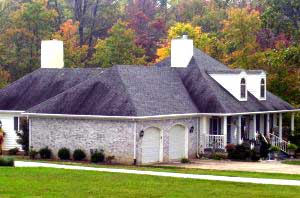Have you looked up at your roof and noticed  black streaks coming down the shingles? If so, you might be looking at roof mold. Unsightly at best, you might be wondering, “Is roof mold dangerous?”
black streaks coming down the shingles? If so, you might be looking at roof mold. Unsightly at best, you might be wondering, “Is roof mold dangerous?”
What is Roof Mold?
Roof mold is a blue-green algae called Gloeocapsa magma that appears like black stains or streaks coming down or across your asphalt roof. It shows particularly well on light-colored shingles and is most prevalent in warm and humid climates.
Is Roof Mold Dangerous?
Any mold is not good for your health, including roof mold. Those with allergies or asthma are especially susceptible to mold spores that could travel from the roof and be inhaled. Roof mold can be transferred into the house through air ducts such as air conditioning system or be washed off of the roof during a rainstorm onto walkways and drives where it can be tracked into the home.
Leaving mold on your roof is not good for your roofing materials either. Left unchecked, it can eat away at or erode the roof, creating costly repairs.
Since roof mold is dark in color, it also attracts sunlight, leading to absorption of the sun’s heat and resulting in higher utility bills.
Related: Facts about Mold and Dampness
How Do I Get Rid of Roof Mold?
According to This Old House, “The least expensive solution is to spray wash the roof with a 50/50 percent mix of water and bleach to get rid of the algae.” Do not use a pressure washer though—that will damage the shingles. Wet the foundation plantings before you start to help protect them from the bleach, and rinse everything in the area after you are done.
Chlorine bleach will deliver the best results on roof mold, but is more erosive than a milder oxygen bleach. Refrain from bleaching your roof too often, as this will weaken the shingles, and wear protection for your skin and eyes when working with bleach.
Pour the bleach solution into a spray bottle and spray the roof mold until wet. Allow it to sit on the roof surface for approximately 15 minutes, then rinse the roof and surrounding area with the garden hose.
“To keep the algae from coming back, insert 6-inch-wide strips of zinc or copper under the row of shingling closest to the roof peak, leaving an inch or two of the lower edge exposed to the weather. Whenever it rains, some of the metal molecules will wash down the roof and kill any algae trying to regain a foothold on your shingles,” This Old House recommends.
In recent years, manufacturers have been using the principles of zinc and copper to include copper granules into their roofing products to inhibit algae growth.
Do You Spot a Construction Defect? Call Först Consulting Group.
Roof mold is not considered a construction defect, but incorrectly-installed roofing is. If you notice a construction defect and need to have an expert verify your concerns or act as your homeowner advocate, contact Först Consulting Group. We can help you get your problem fixed, or help you win your case in court.




